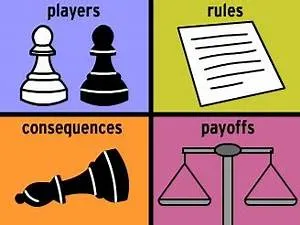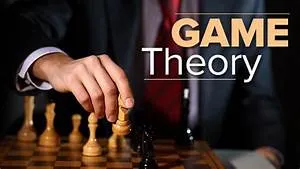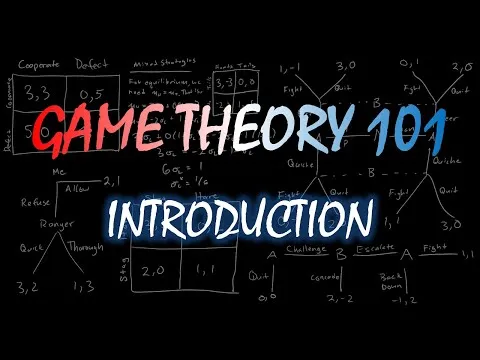First of all, what is game theory about?
Game theory is the study of how and why people make decisions.
It helps people understand parts of science and politics.

Its is the process of modeling the strategic interaction between two or more players in a situation containing set rules and outcomes. While used in a number of disciplines,
game theory is most notably used as a tool within the study of economics.
The economic application of game theory can be a valuable tool to aide in the fundamental analysis of industries, sectors and any strategic interaction between two or more firms.
///
General equilibrium theory>>> can be viewed as a specialized branch of game theory that deals with trade and production, and typically with a relatively large number of individual consumers and producers. It is widely used in the macroeconomic analysis of broad based economic policies such as monetary or tax policy, in finance to analyze stock markets, to study interest and exchange rates and other prices. In recent years, political economy has emerged as a combination of general equilibrium theory and game theory in which the private sector of the economy is modeled by general equilibrium theory, while voting behavior and the incentive of governments is analyzed using game theory. Issues studied include tax policy, trade policy, and the role of international trade agreements.
Decision theory>>> can be viewed as a theory of one person games, or a game of a single player against nature. The focus is on preferences and the formation of beliefs. The most widely used form of decision theory argues that preferences among risky alternatives can be described by the maximization of the expected value of a numerical utility function, where utility may depend on a number of things, but in situations of interest to economists often depends on money income. Probability theory is heavily used in order to represent the uncertainty of outcomes, and Bayes Law is frequently used to model the way in which new information is used to revise beliefs. Decision theory is often used in the form of decision analysis, which shows how best to acquire information before making a decision.
Mechanism design theory>>> differs from game theory in that game theory takes the rules of the game as given, while mechanism design theory asks about the consequences of different types of rules. Naturally this relies heavily on game theory. Questions addressed by mechanism design theory include the design of compensation and wage agreements that effectively spread risk while maintaining incentives, and the design of auctions to maximize revenue, or achieve other goals.
///
We'll take an introductory look at game theory and the terms involved, and introduce you to a simple method of solving games, called backwards induction.
- Game: Any set of circumstances that has a result dependent on the actions of two of more decision-makers (players)
-Information set: The information available at a given point in the game. The term information set is most usually applied when the game has a sequential component.
-Players: A strategic decision-maker within the context of the game
-Strategy: A complete plan of action a player will take given the set of circumstances that might arise within the game
Equilibrium: The point in a game where both players have made their decisions and an outcome is reached.
-Payoff: The payout a player receives from arriving at a particular outcome. The payout can be in any quantifiable form, from dollars to utility.
This video shows you the behavior and outcomes of two or more people in a non-cooperative situation:
One way to describe a game is by listing the players (or individuals) participating in the game, and for each player, listing the alternative choices (called actions or strategies) available to that player. In the case of a two-player game, the actions of the first player form the rows, and the actions of the second player the columns, of a matrix. The entries in the matrix are two numbers representing the utility or payoff to the first and second player respectively. A very famous game is the Prisoner's Dilemma game. In this game the two players are partners in a crime who have been captured by the police. Each suspect is placed in a separate cell, and offered the opportunity to confess to the crime. The game can be represented by the following matrix of payoffs.

GAME-THEORETIC DISTRIBUTED CONTROL:
It focuses on systems where decision making is distributed throughout the system. More formally, each system comprises several individual subsystems, each constrained to making independent decisions in response to locally available information. Some examples are the following:
////
Area coverage: In coverage problems, a collection of mobile sensors in an unknown environment seeks to maximize the area under surveillance. Furthermore, some portions of the environment may carry more weight than others. Applications range from following a drifting spill to intruder detection.
Wind farms: Wind farm control seeks to optimize the power production. Employing control strategies where the individual turbines independently optimize their own power production is not optimal with regard to optimizing the power production in the wind farm (67–70).
Area coverage: In coverage problems, a collection of mobile sensors in an unknown environment seeks to maximize the area under surveillance. Furthermore, some portions of the environment may carry more weight than others. Applications range from following a drifting spill to intruder detection
The overarching goal of such distributed control problems is to characterize admissible decision-making policies for the individual subsystems that ensure the emergent collective behavior is desirable.
////
Summary:
Duopolies are commonly used when explaining sequential games, because they model the interdependence between two firms. We learn in this Learning Path how duopolists react to each other’s actions, how collusions work and how repeated sequential games may change the essence of a game.

Good video series, in my opinion:
More to come :)
Fee free to follow.
Have a nice day!

